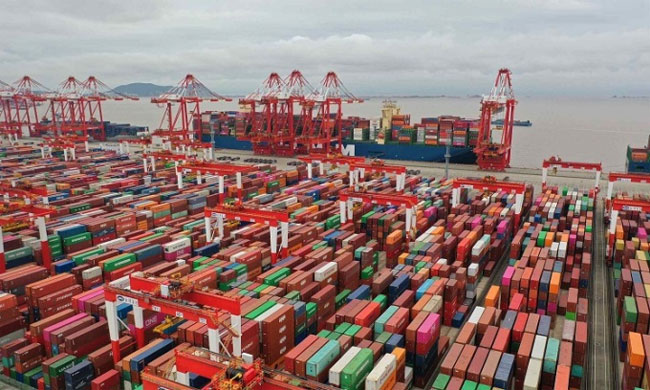The technology behind the world's largest container terminal
The world's largest container terminal in Shanghai concentrates most of the smart technology and large-scale automation in the seaport sector.
Yangshan deep-water port located in Hangzhou Bay is home to the world's largest automatic container terminal , which started operation in December 2017. With an area of 2.23 million m2 and a coastline of 2,350 m, the port can handle 4 million TEUs (TEU is the unit of capacity for standard containers of 6 m) . Despite being crowded, the port employs almost no workers thanks to a fully automated management and control system developed by Shanghai International Port Group (SIPG), which runs the entire process using artificial intelligence. construction, including container loading and unloading, horizontal transportation, yard arrangement.

Duong Son deep-water port on May 19, 2021. (Photo: CFP).
Connected to the main data and information platform of the port of Shanghai, the system efficiently organizes on-site production through collaborative scheduling and process control. Instead of working on site, port operators now work in the control room, doing everything in front of a computer screen. The automatic container berth has 7 berths, which can receive large container ships up to 200,000 tons. Huang Xiusong, director of the technology center at SIPG, said the container terminal can finish loading and unloading 5,000 TEUs within 16-24 hours.
Streamlining the shipping process requires consideration of every detail such as the area where the vessel is parked or the machinery needed to load and unload the cargo. The intelligent system developed by SIPG now replaces manual labor in repetitive work. In the past, experienced workers usually took 3-4 hours to arrange containers for a ship. Currently, the sorting time is reduced to 15 minutes because the automatic system can receive all information from the time the ship enters the mooring position and automatically provide the most effective solution that can help the entire port operate at a faster pace. gentle.
Automatic remote control technology helps operators move from the 50 m high crane cab into the control room. They simply push a button or push a lever to control the operation based on real-time information displayed on the screen. Without remote control technology, the container terminal would need at least 700 workers instead of 100 now, according to Fang Huaijin, SIPG vice president.
The automatic container terminal in Duong Son is also the first place in Asia to apply automatic guided vehicles (AGVs) . Based on ground-mounted magnetic nails, AGV transports containers to the location instead of trucks. The vehicle takes only 6 minutes to change the battery and two hours to fully charge. Moreover, the whole charging process is zero emission, which saves more than 40% of energy consumption. A high degree of automation contributes to outstanding operational efficiency and annual output. In 2018, automatic container terminals handled 2.01 million TEUs. In 2019, the number increased to 3.27 million TEU and in 2020 it will exceed 4.2 million TEU.
The engineering team is aiming to establish a future intelligent control system, integrating cloud computing, big data, artificial intelligence and many other technologies to increase accuracy and safety, operating more efficient and environmentally friendly. The system will help increase the annual capacity of the automatic container terminal to more than 6 million TEUs.
- China shipped the world's largest container ship
- The cargo ship is over 200,000 tons long by four football fields
- China is about to build a giant snow-shaped airport terminal
- The zipper bag has a capacity of 2,000 cubic meters of water
- Container ship with world championship: Carrying 17,603 units, still over 667 seats!
- Agri-Cube - Technology container to increase productivity of aquatic vegetables in the city
- How the Chinese moved the 30,000-ton bus stop to make way for the new train line
- Expression of terminal cancer patients
- Container farms tested in Antarctica before going up ... Mars
- World overview of the world through 10 technology segments
- Why do passengers have to wait long before leaving the plane?
- Experience of surviving doctors with terminal lung cancer
 The US company is about to build a supersonic passenger plane of 6,000km / h
The US company is about to build a supersonic passenger plane of 6,000km / h Japan develops avatar robot as in fiction film
Japan develops avatar robot as in fiction film Australia tested the world's first mango picking robot
Australia tested the world's first mango picking robot America develops technology to separate water from animal waste
America develops technology to separate water from animal waste